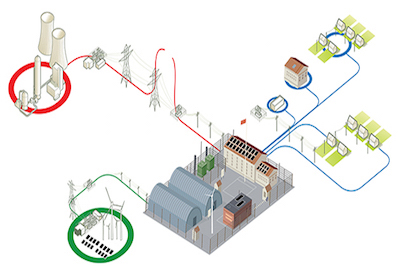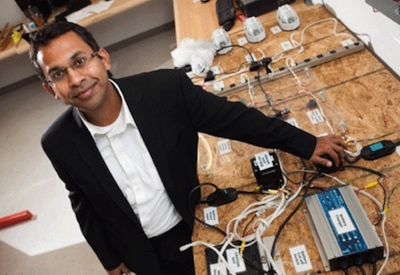Part One: Re-engineering the Grid

Apr 24, 2017
By Paul McMullen
Electricity has been a viable and fundamental power source since Michael Faraday invented the dynamo in 1831. Small scale mini grids supported individual factories or villages and evolved over time to become a large interconnected network.
The power grid as we know it has been in operation in developed countries since the mid 20th century. In this system, power is generated far away from where it was consumed. Huge transmission lines transport power at massive voltages to the localised distribution systems where it is dispersed and consumed.
When blackouts occur, they last for hours and are accepted as a necessary price for the cheap, on-demand access to power the grid afforded.
… But now there is a better way.
The smart grid
In the 21st century, economic health, national security and even the safety and wellbeing of a country’s citizens depend on the reliable delivery of electricity. The old grid, which served the power users of the past, is simply not designed to provide the services modern power users demand of it. Sustained power outages are no longer tolerated and can lead to huge financial losses for commercial and industrial users — effectively grinding the working day to a halt.
{videobox}MLzx50hDZlM{/videobox}
The cost of sustained outages, S&C Electric Company
Power consumers are now demanding more from their electricity provider. Industry has grown dependent on a reliable, electricity source, and even the smallest momentary interruption can cause delays and losses for sensitive processes dependent on good power quality. This absolute dependence on quality power is driving some consumers to install uninterruptable power supplies, energy storage systems [1] or even deploy full microgrid solutions to limit their dependency on the national power network. The evolution of a more reliable power grid grew out of necessity, but now more and more power users are deploying these solutions for sustainability, convenience or financial goals, as the cost of renewable power and battery energy storage packages continues to fall.
With the rise in the Green Agenda, the Energy Trilemma* is becoming a real issue. Energy policymakers, regulators, generators and suppliers are working constantly to carefully balance delivering secure and sustainable energy at a reasonable price.

To satisfy the three conditions of the Energy Trilemma, the grid has to adapt. A linear system with one-way power flow is increasingly being replaced in favour of a dynamic two-way network, where power and data are continuously communicated back-and-forth between the utility and the power user. With the rise of feed-in tariffs and distributed generation, electricity is now being generated in small quantities close to where it is being consumed. Energy storage technology is evolving to store the renewable energy produced at off-peak hours, and dispatch the power of the sun at night and wind on calm days. This requires the distribution system to become more flexible and limits the demand for large transmission lines to be built and maintained. As the localized distribution system takes a larger role in power delivery, a grid made up of connected microgrids is predicted to emerge, where the power grid would act as the fundamental backbone of the “grid-of-microgrids.”
The need for high security of supply and minimized downtime is driving distributed automation to increase reliability. Grid restoration decisions no longer need to be made centrally by a team of engineers, as these tasks are now delegated to smart switches and software which analyse data in seconds to make the decision to reroute power, or switch a microgrid into islanding mode.
These changes are happening now, but the grid is not completely upgraded yet.
The future grid
With the rise of the Internet of Things, distributed generation, electric vehicles and smart meters, the electric grid of the future will be an interconnected web with constant communication among utilities, power users and individual automated smart devices on the network. As the grid becomes more automated, cyber security will increasingly become a concern. However, in the grid of the future, electrical and IT engineers will work together to ensure the secure supply of power to customers and mitigate these concerns. Electricity supply will become more resilient, more reliable and less carbon intensive. With this vision, energy poverty could be eradicated and electricity could be brought to the billions of people in developing countries that currently have no access. However, to achieve this the grid will need to undergo extensive upgrading on a scale that is both costly and daunting.
One thing is certain, the old grid will not be sufficient to serve the demands of the future grid. New bright minds will need to collaborate to ensure that today’s innovations do not cause tomorrow’s problems. The challenges that new engineers face will be different to that of their predecessors. With an education system geared towards solving the problems of the old grid, how will new graduate engineers be prepared for the emerging challenges of the Smart Grid? This issue will be discussed in Part II of this series. Watch for it in an upcoming issue of EIN.
{videobox}2VGs7FdrSIE{/videobox}
From Old Grid to Smart Grid: The Economic Impact on Electricity Customers, S&C Electric Company.
1. Read how one remote town in BC protected itself against power outages with an S&C Electric Canada microgrid solution
*The World Energy Council’s definition of energy sustainability is based on three core dimensions – energy security, energy equity, and environmental sustainability. These three goals constitute a “trilemma,” entailing complex interwoven links between public and private actors, governments and regulators, economic and social factors, national resources, environmental concerns, and individual behaviours. (Ref: www.worldenergy.org/)
Paul McMullen is Vice-President, Canada Business Unit, for S&C Electric Canada Ltd.






![Guide to the Canadian Electrical Code, Part 1[i], 26th Edition– A Road Map: Section 4](https://electricalindustry.ca/wp-content/uploads/2022/11/Guide-CE-Code-2-768x432.png)



![Guide to the Canadian Electrical Code, Part 1[i] – A Road Map: Section 52 — Diagnostic imaging installations](https://electricalindustry.ca/wp-content/uploads/2022/11/Guide-CE-Code-2.png)






